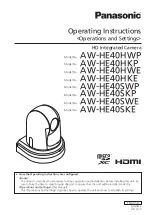
– 84 –
Chapter 4 Shooting — Handling setting data
2
Select [YES] in the confirmation screen and press the control stick (or <SEL/PUSH SET> dial button). (Fig. 1)
Not to format the memory card, select [NO] and press the control stick (or <SEL/PUSH SET> dial button).
3
When the completion message is displayed, select [OK] and press the control stick (or <SEL/PUSH SET> dial button).
For details on error messages, refer to “During thumbnail and menu operation” (page 177).
@
@
NOTE
t
SD memory cards can also be formatted from the thumbnail screen.
For details, refer to “Formatting SD memory cards” (page 108).
t
Data deleted as a result of formatting cannot be restored. Always check the data before formatting.
How to use user data
The content of setting data can be written to and read written data from user area on the internal memory of the camera.
Use of this data allows you to quickly reproduce optimum setup states.
Writing setting data to user area
1
Select [SAVE] in the main menu
→
[OTHER FUNCTIONS]
→
[USER FILE] and press the control stick (or <SEL/PUSH SET> dial
button).
The confirmation screen is displayed.
2
Select [YES] and press the control stick (or <SEL/PUSH SET> dial button).
3
When the completion message is displayed, press the control stick (or the <SEL/PUSH SET> dial button).
Loading written user data
1
Select [LOAD] in the main menu
→
[OTHER FUNCTIONS]
→
[USER FILE] and press the control stick (or <SEL/PUSH SET> dial
button).
The confirmation screen is displayed.
If [SYSTEM RESTART] is displayed on the confirmation screen, the camera will restart after reading out is complete.
2
Select [YES] and press the control stick (or <SEL/PUSH SET> dial button).
Loading of the file begins.
How to use scene file data
The content of setting data can be written to and read written data from scene file area on the internal memory of the camera. Six types of scene files
can be registered. Use of this data allows you to quickly reproduce optimum setup states.
r
Factory settings
[F1:]:
File that is suitable for standard shooting.
[F2:FLUO.]:
The file suitable for shooting when the characteristics of fluorescent light should be considered (such as shooting indoors).
[F3:SPARK]:
The file that sharpens the color hue and contrast and that has suitable resolution for SD shooting.
[F4:B-STR]:
The file suitable for shooting when the tone level of darker areas are to be stretched (such as shooting at sunset).
[F5:CINE V]:
The file suitable for shooting cinematic video that has shaper contrast.
[F6:CINE D]:
The file suitable for shooting cinematic video that has wider dynamic range.
@
@
NOTE
t
[SYSTEM MODE] does not change even if the scene file is changed. Set all items in the main menu
→
[SYSTEM MODE].
Содержание AJ-PX270EJ
Страница 140: ...This chapter describes the screen displayed on the viewfinder or LCD monitor Chapter 7 Display ...
Страница 159: ...This chapter describes how to use the camera by connecting to network Chapter 9 Network Connection ...
Страница 182: ...This chapter describes the specifications of this product Chapter 11 Specification ...
















































